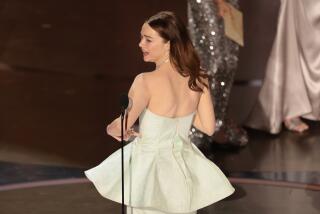Review: âCruellaâ is dazzling fun but shows too much sympathy for the de Vil
The Times is committed to reviewing theatrical film releases during the COVID-19 pandemic. Because moviegoing carries risks during this time, we remind readers to follow health and safety guidelines as outlined by the Centers for Disease Control and Prevention and local health officials.
It may seem counterintuitive, but the easiest way to enjoy âCruellaâ â and itâs plenty enjoyable, even when it overstays its welcome â is to try and forget that it has much of anything to do with âOne Hundred and One Dalmatians.â The filmmakers, of course, do not always make this easy. In line with the Walt Disney Companyâs nostalgia-tickling, franchise-building corporate imperatives, they have been tasked with revisiting that 1961 animated chestnut and spinning off a live-action origin story for its memorable fascist-fashionista villain, Cruella de Vil. And so they pile on the tie-in references galore. Those famous spotted dogs make an appearance. Youâll recognize key supporting characters from their names, like Roger and Anita, Horace and Jasper, and youâll likely also pick up on a snippet of the original filmâs signature tune: âCruella de Vil / Cruella de Vil / If she doesnât scare you, no evil thing will ⌠â
The muddled but intriguing revelation of âCruellaâ is that the thing in question isnât really all that evil. Like so many other storybook villains subjected to elaborate image makeovers, from âWickedâ to âMaleficent,â Cruella â played here by a wholly committed, glammed-to-the-nines Emma Stone â isnât much of a monster. Certainly sheâs a far cry from the shrieking fur-clad demon played by Glenn Close in 1996âs live-action â101 Dalmatiansâ (and its best-unmentioned sequel). Sheâs just impatient, perpetually misunderstood and unwilling to play by the rules of a world that fails to recognize her brilliance.
What this leaves us with, practically speaking, isnât a prequel or an origin story so much as the product of an alternate timeline. By movieâs end, this Cruella seems as likely to skin a dog as she is to wear a T-shirt to the Met Gala. Puppycidal maniacs donât make sympathetic protagonists â and âCruella,â above all, wants you to sympathize.
To that end, our protagonist is introduced as a likably mischievous English tot named Estella (played by Tipper Seifert-Cleveland) who has keen fashion sense, a telltale black-and-white bob of hair and a loving mother (Emily Beecham) who tries to suppress her naturally rebellious streak. But then, before you can say âLemony Snicket,â a series of ghastly incidents leave Estella tragically orphaned and running for her life on the streets of London. When we catch up with her several years later, sheâs a seasoned grifter (now played by Stone), her hair dyed a less obtrusive crimson and her table piled high with magnificent sartorial creations. A master of DIY couture, she sews brilliant disguises for herself and her partners in crime, the bumbling Horace (Paul Walter Hauser, very good) and the sensitive Jasper (Joel Fry, ditto).
These scenes set us adrift in a 1970s London that, like the actual 1970s London, is considerably more racially diverse than earlier Disney entertainments might have bothered to register. The director, Craig Gillespie, and his cinematographer, Nicolas Karakatsanis, send their camera soaring and whooshing through the streets in a movie that surges with infectious punk energy. If the two-guys-and-a-girl antics pack some of the New Wave vitality of âBand of Outsiders,â the serpentine tracking shots and nonstop needle drops often seem to be channeling âGoodfellas.â (The Rolling Stonesâ âSympathy for the Devilâ is merely the most on-the-nose choice on a rebellion-themed soundtrack crammed with â60s and â70s hits like âFeeling Good,â âShould I Stay or Should I Goâ and, fittingly for this leading lady, âStone Cold Crazy.â)
Gillespie makes a pretty snug fit for this material after his darkly comic Tonya Harding biopic, âI, Tonyaâ; you could think of this superior follow-up as âI, Cruella,â another cracked portrait of a downtrodden but determined young woman none-too-reliably narrating the story of her many rises and falls. But then, you could also see it as the latest variation on a classic fairy-tale template: The screenwriters, Dana Fox and Tony McNamara (a writer on Stoneâs 2018 film, âThe Favouriteâ), shrewdly position Estella as a kind of shabby-chic Cinderella, albeit one who dresses up for a different ball every night and dreams of revenge rather than Prince Charming.
Every Cinderella needs a wicked stepmother, and here that role falls to the imperious Baroness von Hellman, played by an impossibly elegant and diabolical Emma Thompson. (The Miranda Priestly vibes are far from coincidental; Aline Brosh McKenna, who receives a story credit here, also wrote âThe Devil Wears Prada.â) When Estella lucks her way into a job as a designer at the Baronessâ ultra-prestigious label, she initially canât believe her good fortune â but then, through a series of cleverly interlocking revelations, she comes to learn that the Baroness is more than just an unusually demanding boss. Sheâs a dangerous narcissist and an unambiguous monster, someone who deserves to be humiliated, disgraced and finally toppled from her throne.
And so Estella unleashes her long-dormant alter ego, Cruella, who begins crashing the Baronessâ nightly galas with a succession of stunning gowns and a natural flair for shock-the-runway theatrics. Whether sheâs strutting about in shiny black leather, incorporating wearable flammables or â in a jaw-dropping visual highlight â trailing a mile-long chiffon train from the back of a garbage truck, Cruella soon establishes herself as the glam-punk performance artist of the fashion world. Besides relying on muscle from Horace and Jasper, she borrows some queer-eye inspiration from Artie, a vintage dress-shop owner played by a fine if underused John McCrea. (The genius behind Cruellaâs artistry is the endlessly inventive costume designer Jenny Beavan, in her most extravagant showcase since âMad Max: Fury Road.â)
The battle of the Emmas is as hard to resist on-screen as it must have been on paper, even if itâs not exactly a fair fight. In the context of the story, Cruellaâs headline-grabbing stunts make her a persistent thorn in the Baronessâ side; in terms of pure on-screen magnetism, itâs a different story. Few can do withering arrogance with more offhand conviction than Thompson, the kind of actor who can raise a glass to herself (âHereâs to meâ) as if it were the most logical thing in the world. Sheâs a total hoot. She also winds up illuminating a deeper conceptual flaw in âCruellaâ and perhaps the larger cottage industry of recasting memorable baddies as tortured antiheroes. In a movie ostensibly about the origins of a great villain, itâs Thompsonâs Baroness who comes off as the actual great villain.
Stone of course has trickier, more complicated notes to play. Curiously enough, her most satisfying moments belong to Estella, quietly biding her time and plotting her next move, rather than to Cruella, an indistinct presence who often seems in danger of being upstaged â sometimes upholstered â by her own couture. But if Stone has trouble navigating her inner Jekyll-and-Hyde dynamic, thatâs largely due to the herky-jerky imprecisions in the script, which seems uncertain whether to make the emergent Cruella merely misguided, borderline unhinged or genuinely unscrupulous â and finally settles on a coy, unsatisfying mix of all three.
Itâs instructive that in âThe Favourite,â one of a few recent films to feature as many ruffled gowns and sky-high wigs as this one, Stone nailed every nuance as another lowly young woman turned ambitious schemer. That movie reveled in its moral ambiguities; âCruella,â trying to do something similar, is ultimately stymied by them. While its surface pleasures are dazzling â if a bit protracted, at well north of two hours â it finally suggests that memorable screen villainy and complex inner humanity may be forced into a kind of stalemate, at least when thereâs a corporate-branded intellectual property involved. âCruellaâ isnât a bad movie, even if its heroine is nowhere near bad enough.
âCruellaâ
Rated: PG-13, for some violence and thematic elements
Running time: 2 hours, 14 minutes
Playing: Opens May 28 in theaters and streaming as PVOD on Disney+
More to Read
Only good movies
Get the Indie Focus newsletter, Mark Olsen's weekly guide to the world of cinema.
You may occasionally receive promotional content from the Los Angeles Times.











